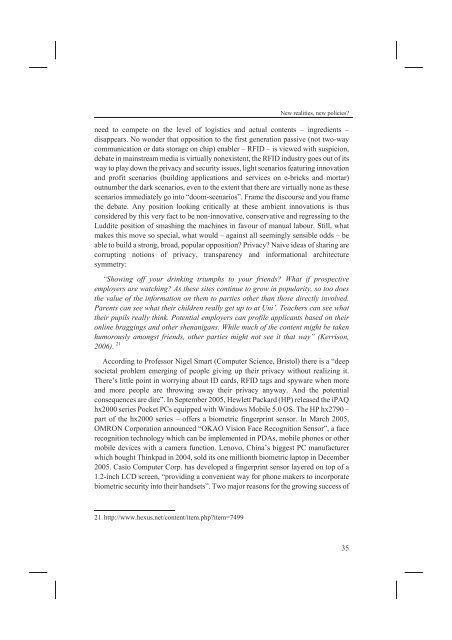D:\Documents and Settings\Ana\My Documents\Biserka-knjiga ...
D:\Documents and Settings\Ana\My Documents\Biserka-knjiga ...
D:\Documents and Settings\Ana\My Documents\Biserka-knjiga ...
You also want an ePaper? Increase the reach of your titles
YUMPU automatically turns print PDFs into web optimized ePapers that Google loves.
need to compete on the level of logistics <strong>and</strong> actual contents – ingredients –<br />
disappears. No wonder that opposition to the first generation passive (not two-way<br />
communication or data storage on chip) enabler – RFID – is viewed with suspicion,<br />
debate in mainstream media is virtually nonexistent, the RFID industry goes out of its<br />
way to play down the privacy <strong>and</strong> security issues, light scenarios featuring innovation<br />
<strong>and</strong> profit scenarios (building applications <strong>and</strong> services on e-bricks <strong>and</strong> mortar)<br />
outnumber the dark scenarios, even to the extent that there are virtually none as these<br />
scenarios immediately go into “doom-scenarios”. Frame the discourse <strong>and</strong> you frame<br />
the debate. Any position looking critically at these ambient innovations is thus<br />
considered by this very fact to be non-innovative, conservative <strong>and</strong> regressing to the<br />
Luddite position of smashing the machines in favour of manual labour. Still, what<br />
makes this move so special, what would – against all seemingly sensible odds – be<br />
able to build a strong, broad, popular opposition? Privacy? Naive ideas of sharing are<br />
corrupting notions of privacy, transparency <strong>and</strong> informational architecture<br />
symmetry:<br />
“Showing off your drinking triumphs to your friends? What if prospective<br />
employers are watching? As these sites continue to grow in popularity, so too does<br />
the value of the information on them to parties other than those directly involved.<br />
Parents can see what their children really get up to at Uni’. Teachers can see what<br />
their pupils really think. Potential employers can profile applicants based on their<br />
online braggings <strong>and</strong> other shenanigans. While much of the content might be taken<br />
humorously amongst friends, other parties might not see it that way” (Kerrison,<br />
2006). 21<br />
According to Professor Nigel Smart (Computer Science, Bristol) there is a “deep<br />
societal problem emerging of people giving up their privacy without realizing it.<br />
There’s little point in worrying about ID cards, RFID tags <strong>and</strong> spyware when more<br />
<strong>and</strong> more people are throwing away their privacy anyway. And the potential<br />
consequences are dire”. In September 2005, Hewlett Packard (HP) released the iPAQ<br />
hx2000 series Pocket PCs equipped with Windows Mobile 5.0 OS. The HP hx2790 –<br />
part of the hx2000 series – offers a biometric fingerprint sensor. In March 2005,<br />
OMRON Corporation announced “OKAO Vision Face Recognition Sensor”, a face<br />
recognition technology which can be implemented in PDAs, mobile phones or other<br />
mobile devices with a camera function. Lenovo, China’s biggest PC manufacturer<br />
which bought Thinkpad in 2004, sold its one millionth biometric laptop in December<br />
2005. Casio Computer Corp. has developed a fingerprint sensor layered on top of a<br />
1.2-inch LCD screen, “providing a convenient way for phone makers to incorporate<br />
biometric security into their h<strong>and</strong>sets”. Two major reasons for the growing success of<br />
21 http://www.hexus.net/content/item.php?item=7499<br />
New realities, new policies?<br />
35



